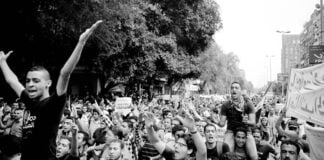The years after 1969 in Italy showed the potential for mass radicalisation of the working class within western capitalism, argues Judy McVey
The French ten million strong general strike and student uprising of May 1968 is the best known radical event of the 1960s.
Less well known but more long-lasting were the actions which became know as Italy’s “hot autumn” of 1969.
Many people think that the 1960s was simply a youth revolt led by hippies and counter culturalists.
It was also the period of mass movements worldwide against the Vietnam war and against sexism and homophobia.
Yet it was the radicalisation of factory workers in key western economies that posed the most serious challenge to capitalism.
In Italy the effects penetrated deep into Italian society and culture. The Catholic Church’s conservatising role was clearly pushed back with the defeat of a right wing referendum on divorce.
The struggle itself gave workers a new self-confidence and was seen as a “golden era” according to historian Paul Ginsborg.
By the early 1970s a new revolutionary left—with three daily papers and tens of thousands of activist members, was born. Workers, influenced by the far left, rejected the old unions and fought for greater democracy and control over their actions.
The struggle was so intense that workers who had previously never been on strike were now telling the boss what to do. The scale of the radicalisation could have been the basis for a new society where the economy was run under workers’ democratic control—but sadly the new revolutionary organisations were not to be up to the task.
Migration, instability, social crisis
In the early 1960s Italian society was dominated by the right wing Christian Democratic Party, reinforced through mass organisations like Catholic Action with its three million members and the Italian Christian Workers Association with one million.
The Italian economy grew rapidly during the post-war boom of the 1950s. Northern factories, hungry for labour, sucked in young peasants from the countryside and southern Italy.
Working conditions were terrible. The union movement was weak and divided between two main union federations. Many of Italy’s largest factories were virtually without union organisation.
Signs of dissatisfaction turning to revolt could be seen as early as 1962-1963, when 90,000 workers were on strike against harsh factory discipline and poor pay. The most right wing union, UIL, was the focus of a riot in Turin’s Piazza Statuto by angry FIAT workers.
1968—student power
Students were the first to explode into a mass movement against overcrowding in the university system. The universities had grown in response to the need for skilled technical workers.
The result was that in 1967 just 3000 lecturers were responsible for 450,000 students. Complaints about conditions were ignored and the ensuing protests were met by police attacks.
The students formed a national organisation committed to “Potere Studentesco” (student power). According to historian Steve Wright: “Lively and confrontationist, the new movement was notable … for its efforts to redefine the very notion of politics, constructing forms of organisation – above all, the permanent assembly—which simply and brutally swept the traditional student bodies aside.”
The students were influenced by the explosion in activism around the world, particularly Vietnam, the US Black Power movement, Che Guevara and China’s Cultural Revolution which was seen as radically anti-authoritarian.
They quickly became very hostile to Stalinism and the so-called Communist states, particularly Italy’s Communist Party, the PCI—the major party on the left at the time with over a million members.
However, groups of radical intellectuals called “workerists” gained influence among the students. In the context of “student power” politics, workerism took things forward because it reoriented the struggle toward the working class—just as an enormous worker revolt was beginning.
By early 1968 some students were attempting to relate to a strike at the Pirelli factory. In May there were spontaneous strikes by a sections of the workers there hostile to the weak lead of the union officials.
More than 1000 workers were on strike in August, and in September the strikes became almost daily among up to 3000 workers on one day. According to one commentator, “the factory was almost at a standstill.”
Worker student unity
On May 1, 1969, Italy’s largest factory, the FIAT factory in Turin, moved into action. The strikes continued for most of May and June.
Many of the new semi-skilled workers were women, whose complaints about speed-ups, foremen and reduced pay rates and conditions on the job found little sympathy among the male-dominated union ‘internal commissions’ in the workplace, let alone at official level.
Militants began organising themselves in the Unitary Rank and File Committee (in Italian, the initials CUB), and worked with student revolutionaries.
In Turin, meetings of workers and students were held in bars where they discussed and prepared daily action bulletins headed “Lotta Continua” (“the fight goes on”).
When the unions called a one-day strike on July 3, these militants supported it, organising a demonstration which turned into the Battle of Corso Traiano—workers built barricades, and fought police all day and into the night.
The official slogans were “no more rent rises”; the militants chanted: “What do we want? Everything!”
Revolutionary socialists had influence in about a dozen factories. One 10,000-strong demonstration took up the chant against the head of FIAT: “Agnelli, Indochina (Vietnam) is in your factory.”
The period of three months strike action, from September to November 1969 is best summed up by this quote from the British Socialist Worker of the time: “In spite of repeatedly losing more than half their pay, the strikers have not budged from their basic demands for recognition of their new democratic organisations in the factories, the right to local negotiation, reduction of working hours to 40 a week and the regrading of their insurance, pension and social benefits to the level of white collar workers.”
The process of asserting control in their workplaces was giving workers a sense of their own power to run society.
One young woman migrant worker explained how she felt transformed from feeling totally isolated in the new work environment to becoming a “chatterbox”. She began to get a “lot out of going to work in a factory. You learn things directly. Not like a housewife who learns things second hand.”
Mario Mosca, one of the founders of the CUB at Pirelli Bicocca, summed up 1968: “It was the year in which as a worker I felt myself to be a protagonist and the master of my fate. And I continued to have that sensation for the following two years. It was wonderful to be alive.”
Turning point—the factory councils
Workers’ struggle continued from 1968 until 1973, destabilising the political and economic system.
Meanwhile the establishment was desperate bring an end to the movement. But it was the mainstream left, in particular the PCI and the official union leaderships, that played the key role in winding down the struggle.
By 1970-71, new democratic factory councils were agreed to by the unions. The councils represented both a victory for militants and a way for the union leaders to bring the struggle under their control.
Such was the level of uncontrollable struggle, the union officials were forced to “ride the tiger”, as Ginsborg argues, in order to maintain their leadership positions and win control back.
Trade union membership grew from four million in 1968 to 6.675 million in 1975. The left CGIL membership among teachers grew from 4000 to 90,000.
Many of the revolutionaries opposed the factory councils, arguing that spontaneity was being sacrificed.
Yet, rather than outright oppose the factory councils, the revolutionaries could have organised within them to win workers away from conservative leaders.
The spontaneity of the struggle was its strength but needed to be matched by leadership and organisation. In particular, the revolutionaries were competing with mass reformist organisations like the PCI.
The uneven consciousness of the working class, a result of a divisive capitalist society, demands revolutionary organisation that can politically relate inside and beyond the militant factories to the whole class.
The most radical workers were influenced by Marxism, at certain points in the struggle, revolution seemed imminent. The period of political upheaval could have been the prelude to revolution, but the revolution did not emerge.
When the movement suffered setbacks, many drew the conclusion that such thoroughgoing change was not really possible. Others blamed the role of the established social democratic and communist parties or the lack of consciousness of the workers.
Gradually the revolutionary groups fragmented, some collapsing into electoral politics and supporting a more radical reformism around the PCI, others were caught up in anti-fascist violence.
The end of the hot autumn was a product of the political weakness of the new revolutionary left.
But the lesson for radical activists today is that explosions of workers’ struggle have been part of the recent history of Western capitalism—with the power to potentially transform society. Italy after 1969—which experienced the largest working class revolt in the industrialised west—is among the most powerful examples.




